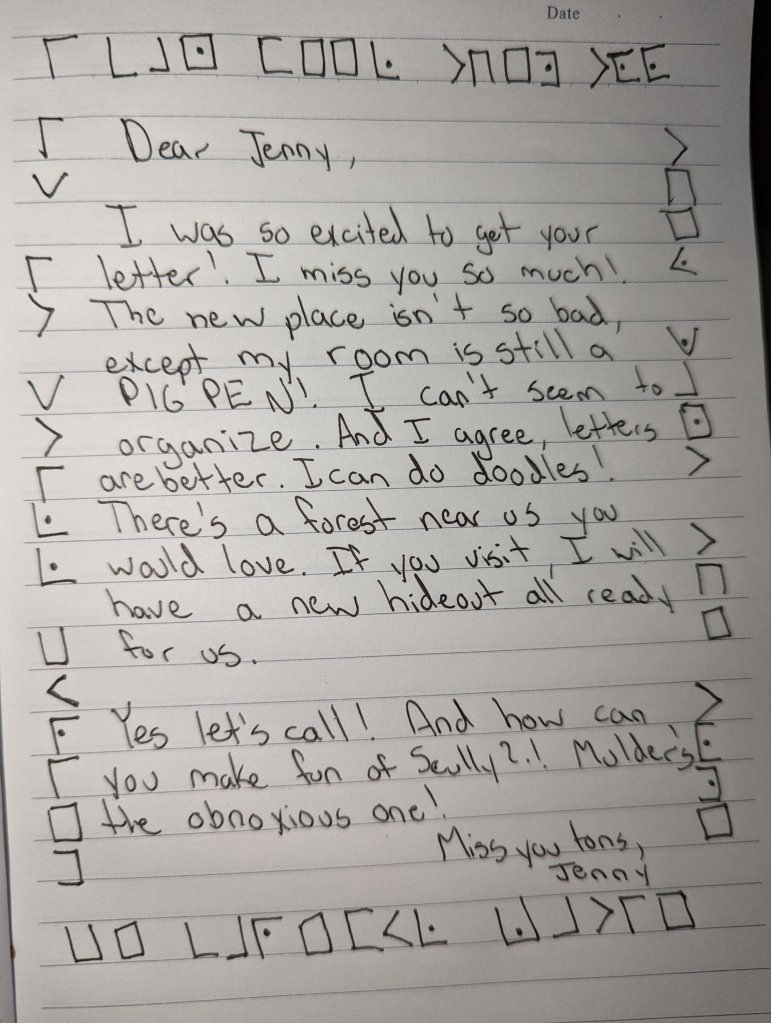Blog Archives
Manda Makes a Game Part 7: Testing
Testing a game is an essential and integral part of the design process.
I didn’t do enough of it.
End of post!
Just kidding, of course. About the end of the post, I definitely did not do enough testing.
Even with the limited testing I did have though, I learned a lot about the process.
One of my challenges was that the majority of my testing was done online. Admittedly, this time around I chickened out of doing a couple of in-person tests. I’ve never been great at asking people to sacrifice their time to do stuff for me, and a small part of fear of having to face people physically who hated the game miiiight have played a small part. It’s something I hope I can rectify in the future.

I quickly realized that testing a physical game over Discord and Zoom chats presented some challenges. I don’t think I appreciated with a physical game how much being able to pick up objects and documents at a whim played a part in the experience.
For example, I had the one puzzle which involved placing a ring on a piece of paper to look like the number 8. In the couple of in-person tests I managed, it was one of the first puzzles solved. In the digital tests though, where I used photos to demonstrate the different stages of the puzzle, it was one of the puzzles players struggled most with. My testers confirmed that the ability to physically hold the ring and manipulate it seemed to make all the difference to figure out what to do with it.

Another challenge for me was learning how to listen to my testers, who were not always verbose. I tend to forget that I am a verbal processor, meaning I best process thoughts by talking them out loud. This kind of makes me an ideal in-person beta tester because I am constantly talking through my thought process. Not everyone best thinks this way though, with many trying to think of solutions purely in their head. It made me realize I would have to be better at listening to not just their verbal cues, but any visual cues as well, or to be better able to sense their emotions while solving. Was it taking too long? Were they too frustrated? I don’t know that I did the best job with it, but I did learn.
I also need to try and think of better ways to ask questions post-testing to see what people thought. Asking in the moment is kind of a double edged sword. On the one hand, that is when memories are freshest. On the other, letting the experience sink in so that the tester can parse out why they might have struggled with certain puzzles is very beneficial as well. What I had to manage most during this process was my own anxiety, accepting that someone not being able to articulate what they thought was not necessarily a bad thing.
There was a lot of great stuff though that came out purely from the testing process. The biggest of these things was working out my hinting. Originally, the UV light in the game was used purely for one puzzle. But of course, what does someone do when presented with a fun purple light that reveals secret messages? Shine it on everything they can. I wanted to reward that fun and curiousity. Combine this with players wondering where to place objects or me wondering where I can put a morse code legend, and the solution presented itself. The UV light could be used to help clue players on how to solve puzzles. This ended up making all the difference.

Overall, it was a good experience testing out my first game. There is a lot I would do differently, and hopefully future games I will be a testing machine!
Test your games, everyone. It’s important.
Manda Makes a Game Part 6: Audio Adventures
Once I had locked in my flow, my script, and my puzzles, I was finally ready…to record.
Oh boy.
Oh boy oh boy oh boy. This ended up being…quite the process. Get ready for mostly GIFs…because, WordPress won’t let me upload videos of the tape recordings.
Recording was the thing that was on my mind all throughout the process but that I had no clue how it would truly go until I actually did it.
Read the rest of this entryManda Makes A Game Part 3: Narrative Considerations and Influences
To understand the rest of the design process for this game, I’m going to have to actually talk about the narrative first. Because it’s me. At the same time though…this is one of the more difficult things to talk about process wise. So..SPOILERS, if you ever actually want to play the game (likely not) and for my Secret Santa.

Manda Makes a Game Part 2: Spreadsheets, Scripts, and Flow
Am I procrastinating actually writing the game by writing about the process of writing a game?
Maybe.
While I am writing this blog series in real time, I am not releasing them until my game is safely shipped to avoid spoilers to my Secret Santa. I’m also writing these kind of piecemeal so while it looks like I had a very organized process where I went from one phase to the next with ease…that’s not really true. Things followed a general timeline, but there were lovely chaotic bits where I was brainstorming, writing, and gathering materials at the same time. But I figured splitting up blog posts by topic is far easier than bringing you 100% along my chaotic journey of madness. This time around, let’s focus on general organization!

An Escape Enthusiast Abroad: Netherlands Day 5
I am sitting in the airport writing this and feeling more than a little sad that our escape adventure is over for the time being, but at the same time sooooo happy that it got to happen!
Our final day also had a single escape room. Mondays are usually dark days for escape rooms, but Escape Room Junkie was very gracious when we were booking rooms back in May and were willing to have us book their game, Corpse Inc., with them on a Monday! We were very grateful.
Read the rest of this entryAn Escape Enthusiast Abroad: Netherlands Day 4
My feet are very sore. Many parts of my body feel bruised. But I had a very fun day. Just one escape today: Dark Park’s Stay in the Dark!
Read the rest of this entryAn Escape Enthusiast Abroad: Netherlands Day 3
Ohhhh my goodness. We did not get back to our hotel until 1am. I don’t think I have fallen asleep so fast in a long time.
Today I woke up far more refreshed. Which is a good thing because there was some trekking to be done today.
Read the rest of this entryAn Enthusiast Abroad: Netherlands Day 2 (Amsterdam)
You know, I didn’t bring my laptop with me because it would be too cumbersome. But now, I remember how much I hate typing on my phone. It takes so much longer!
Read the rest of this entryAn Escape Enthusiast Abroad: Netherlands 2 Electric Boogaloo- Day 1
I am back! And abroad! Yes, after a long period of withdrawal I am back on an escape room trip. Not only is it another escape room trip, but a return to the Netherlands no less!
This time around I am with my regular crew: Errol, his sister Lizette, our friend Margaux and special guest Myra, who we met during the pandemic and became a regular part of our online escape crew! It is great meeting her in person! The whole trip started because Lizette was going to be hanging around Europe for 2 weeks, so we figured, why not plan escapes around it?
Read the rest of this entryEnigMarch Day 19
Here is my EnigMarch attempt for Day 19!! This time I handwrote it out. You can see the explanation and my first attempt at EnigMarch here.
I am finding I am enjoying the challenge of fitting in a cipher into the content of a letter, and the different ways it can be done. Where am I going with the narrative? Not sure yet! But I am liking the process.









